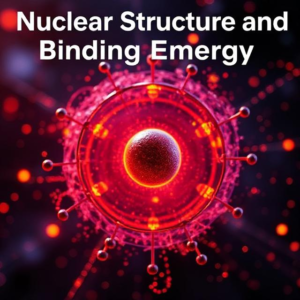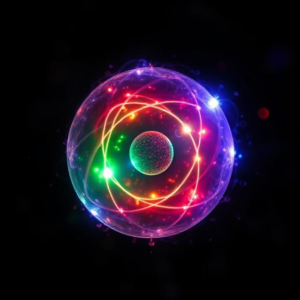Nuclear Structure and Binding Energy
What is Nuclear Structure?
The nucleus is the central part of an atom, and it contains two types of particles:
- Protons: These are positively charged particles.
- Neutrons: These are neutral particles (they have no charge).
Together, protons and neutrons are called nucleons, and they are tightly packed inside the nucleus

Key Features of Nuclear Structure:
- Nucleus Composition:
- The nucleus consists of protons and neutrons. The number of protons in the nucleus determines the element (for example, hydrogen has 1 proton, helium has 2 protons, etc.).
- The total number of protons and neutrons gives the mass number of the atom.
- Nuclear Force:
- Protons and neutrons in the nucleus are held together by a very strong force called the nuclear force (also called the strong force). This force is much stronger than the electromagnetic force that causes like charges to repel (like protons repelling each other).
- The nuclear force is very strong but only works over very short distances, typically within the nucleus itself.
- Protons and Neutrons Interaction:
- Protons repel each other because they have the same positive charge. However, the strong nuclear force between protons and neutrons overcomes this repulsion and keeps the nucleus stable.
- Neutrons don’t have a charge, but they are important because they add stability to the nucleus by helping to balance out the repulsion between protons.
- Nuclear Stability:
- The stability of a nucleus depends on the balance between the electromagnetic force (which pushes protons apart) and the nuclear force (which pulls protons and neutrons together).
- Larger nuclei (with more protons and neutrons) often need more neutrons to stay stable because the repulsion between many protons becomes stronger as the nucleus gets bigger.
What is Binding Energy?
Binding energy is the energy required to break a nucleus into its individual protons and neutrons. In simpler terms, it’s the energy that holds the nucleus together. The higher the binding energy, the more tightly the nucleons (protons and neutrons) are held together, and the more stable the nucleus is.
Key Points:
- Binding energy is the energy that binds protons and neutrons together in the nucleus.
- This energy is released when a nucleus is formed, and it’s required to break the nucleus apart (which is why it’s called “binding energy”).
How is Binding Energy Related to Mass?
Binding energy is closely related to the mass of the nucleus. In fact, mass and energy are interchangeable (thanks to Einstein’s famous equation
, where
is energy,
is mass, and
is the speed of light).
Here’s the relationship:
- The total mass of a nucleus is always slightly less than the combined mass of the individual protons and neutrons that make it up. This difference in mass is called the mass defect.
- The missing mass is converted into binding energy, which is the energy that holds the nucleus together.
Formula for Binding Energy:
The binding energy can be calculated using Einstein’s equation:
Where:
is the binding energy.
is the mass defect (the difference between the mass of the separate nucleons and the mass of the nucleus).
is the speed of light (a very large number, so this equation gives a lot of energy even for small mass differences).
Why is Binding Energy Important?
- Stability of Nucleus:
- The higher the binding energy, the more stable the nucleus is. Stable nuclei have a high binding energy because the protons and neutrons are tightly bound together.
- Less stable nuclei (like those in radioactive materials) have lower binding energies and may break apart more easily, releasing energy.
- Nuclear Reactions:
- Fission: When a heavy nucleus (like uranium) splits into two smaller nuclei, energy is released because the total binding energy of the products is greater than that of the original nucleus. This is the principle behind nuclear reactors and atomic bombs.
- Fusion: When two light nuclei (like hydrogen) combine to form a heavier nucleus (like helium), energy is also released because the binding energy of the fused nucleus is greater than that of the separate nuclei. This is the process that powers the sun and other stars.
How Binding Energy Affects Different Nuclei
The binding energy per nucleon (per proton or neutron) changes with the size of the nucleus. Here’s how it works:
- Light Elements (like hydrogen, helium):
- In light elements, each nucleon is not very tightly bound. So, the binding energy per nucleon is relatively low.
- Medium-Sized Elements (like carbon, oxygen):
- These elements have higher binding energies per nucleon because the nucleons are more tightly bound. The peak of binding energy occurs in the middle of the periodic table, around elements like iron and nickel.
- Heavy Elements (like uranium):
- As elements get heavier, their binding energy per nucleon decreases. This means that while the total binding energy is higher for heavy nuclei, the binding energy per nucleon is lower.
- This is why heavy elements like uranium can undergo fission, releasing a lot of energy.
Summary of Nuclear Structure and Binding Energy
- Nuclear Structure:
- The nucleus is made of protons and neutrons, which are held together by the strong nuclear force.
- The protons repel each other due to their positive charge, but the nuclear force between protons and neutrons keeps the nucleus stable.
- Larger nuclei need more neutrons to balance the repulsive forces between protons.
- Binding Energy:
- Binding energy is the energy required to hold the nucleus together, and it’s also the energy needed to break the nucleus apart.
- This energy is related to the mass defect, or the difference between the mass of the separate nucleons and the mass of the nucleus.
- Energy and Stability:
- A high binding energy means the nucleus is stable. Low binding energy means the nucleus is less stable and more likely to undergo fission or decay.
- The binding energy per nucleon is highest in medium-sized atoms (like iron), and this explains why both fission and fusion release energy.
In Simple Terms:
- Nuclear Structure: The nucleus is made up of protons and neutrons that are tightly held together by a strong force.
- Binding Energy: This is the energy that holds the nucleus together, and it’s released when the nucleus is formed. The higher the binding energy, the more stable the nucleus is.
- Mass and Energy: A nucleus has less mass than the sum of its protons and neutrons because the missing mass is converted into binding energy, which is what keeps the nucleus stable.











